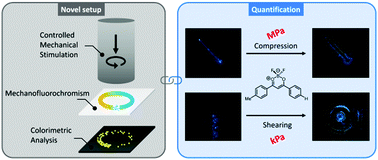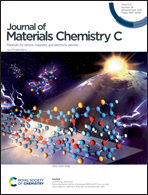Quantification of mechanofluorochromism at the macroscale via colorimetric analysis of controlled mechanical stimulation†
Abstract
The use of mechanofluorochromic (MFC) molecular materials as mechanical stress probes is challenging since quantitative studies of this phenomenon remain rare. The most common approach to quantify the fluorescence response of MFC materials involves a diamond anvil cell. However, this requires high isotropic pressures, which are far from ordinary conditions. We report here the design of a setup able to apply anisotropic mechanical stimuli such as pure unidirectional compression and shear stress, both controlled in intensity. A well-known MFC compound, DFB-H, was submitted to pure compression or shearing while simultaneously recording fluorescence movies. DFB-H crystals were found to be responsive to both types of stimuli but subsequent data analysis revealed higher sensitivity to shearing than to pure compression. Indeed, fluorescence colour change was detected by colorimetric analysis and linked to the intensity of applied force to estimate a threshold. DFB-H MFC response was observed for pressures on the order of tens of MPa whereas only a few kPa were enough to induce MFC response by shearing. This novel setup, combined with a colorimetric analysis, is a promising approach for quantification of MFC response at the macroscale and for future development of mechanical stress probes.



 Please wait while we load your content...
Please wait while we load your content...